What is a Phidget?: Difference between revisions
No edit summary |
|||
| (10 intermediate revisions by 3 users not shown) | |||
| Line 1: | Line 1: | ||
[[Category:Overview]] | [[Category:Overview]] | ||
__NOTOC__ | |||
At Phidgets, our philosophy is that you don't have to be an electrical engineer in order to create sophisticated projects using motors, sensors and other electronics. You simply need to know how to code. | |||
Phidgets are building- | Phidgets are building-blocks for sensing and control using a computer, tablet, or phone. Phidgets enable your software application to interact with the physical world. | ||
[[File:HUB0000 with LED Image.jpg|link=|250px]] [[File:RFID Image.jpg|link=|250px]] [[File:STC1000 with Motor Image.jpg|link=|300px]] | |||
[[File:NoBreadboard.jpg|right|link=|180px]] | |||
The advantage of using Phidgets is that all Phidgets can be plugged in and used in your project out of the box, without having to follow complex pinout diagrams or configure communication between the device and computer. With Phidgets, we deal with the details of getting the electronics behaving as they should, so you can focus on the programming and details of your final product. | |||
<br clear="all"> | |||
==Hardware Introduction== | |||
Phidgets connect via a USB port: | |||
[[Image:wiap-image1.jpg|500px|link=|alt=|center]] | [[Image:wiap-image1.jpg|500px|link=|alt=|center]] | ||
| Line 8: | Line 21: | ||
---- | ---- | ||
Some Phidgets are a complete, self-contained sensing package. An example is the [{{SERVER}}/products.php?product_id=1042 1042] | |||
Some Phidgets are a complete, self-contained sensing package. | |||
, which measures motion: | , which measures motion: | ||
[[Image:wiap-image2-spatial.jpg|500px|link=|alt=|center]] | [[Image:wiap-image2-spatial.jpg|500px|link=|alt=|center]] | ||
| Line 16: | Line 28: | ||
---- | ---- | ||
Other Phidgets are a 'building block' to use other sensors. An example is the [{{SERVER}}/products.php?product_id=1048 1048] which allows the use of wire thermocouples: | |||
[[Image:wiap-image2-temp.jpg|700px|link=|alt=|center]] | [[Image:wiap-image2-temp.jpg|700px|link=|alt=|center]] | ||
| Line 24: | Line 35: | ||
Finally, a Phidget may be a [{{SERVER}}/?view=comparetable&rel=VINTHub VINT Hub], made up of versatile ports that can be used as inputs or outputs, and also connect to smart [[What_is_VINT?|VINT]] devices. | |||
[[Image:wiap-vint.jpg|700px|link=|alt=|center]] | [[Image:wiap-vint.jpg|700px|link=|alt=|center]] | ||
==Programming== | ==Programming== | ||
For the most part, using Phidgets requires writing software. The '''Phidgets API''' is available in many different programming languages: | |||
{{Programming Languages Table}} | |||
The Phidget software libraries are supported on a number of operating systems: | |||
{| style="border:1px solid darkgray;" cellpadding="7px;" | {| style="border:1px solid darkgray;" cellpadding="7px;" | ||
|-style="background: #f0f0f0" align=center | |-style="background: #f0f0f0" align=center | ||
| Line 112: | Line 51: | ||
|'''Desktop OSes''' || |'''Mobile/Wireless OSes''' | |'''Desktop OSes''' || |'''Mobile/Wireless OSes''' | ||
|- | |- | ||
|[[Image:Icon-Windows.png|alt=OS - Windows|24x24px|link=OS - Windows]][[OS - Windows|Windows]] || |[[Image:Icon- | |[[Image:Icon-Windows.png|alt=OS - Windows|24x24px|link=OS - Windows]][[OS - Windows|Windows]] || |[[Image:Icon-Phidgets.png|alt=OS - Phidget SBC|24x24px|link=OS_-_Phidget_SBC]][[OS_-_Phidget_SBC|Phidget SBC]] | ||
|- | |- | ||
|[[Image:Icon-Linux.png|alt=OS - Linux|24x24px|link=OS - Linux]][[OS - Linux|Linux]] || [[Image:Icon-iOS.png|alt=OS - iOS|link=OS - iOS|24x24px|link=OS - iOS]][[OS - iOS|iOS]] | |[[Image:Icon-Linux.png|alt=OS - Linux|24x24px|link=OS - Linux]][[OS - Linux|Linux]] || [[Image:Icon-iOS.png|alt=OS - iOS|link=OS - iOS|24x24px|link=OS - iOS]][[OS - iOS|iOS]] | ||
|- | |- | ||
|[[Image:Icon-Mac-OS.png|alt=OS - OS X|24x24px|link=OS - OS X]][[OS - OS X|OS X]] | |[[Image:Icon-Mac-OS.png|alt=OS - OS X|24x24px|link=OS - OS X]][[OS - OS X|OS X]] || [[Image:Icon-Android.png|alt=OS - Android|link=OS - Android|24x24px|link=OS - Android]][[OS - Android|Android]] | ||
|} | |} | ||
== Network Server == | == Network Server == | ||
Using the Phidgets API, applications on remote computers, phones, and [[OS_-_Phidget_SBC|Single Board Computers]] can attach to Phidget devices over the network as if they were local. This includes WWW based applications using the Phidget JavaScript library. | |||
[[Image:NetworkServer_PhidgetServer.jpg|link=|800px|center]] | [[Image:NetworkServer_PhidgetServer.jpg|link=|800px|center]] | ||
== Further Reading == | == Further Reading == | ||
| Line 134: | Line 67: | ||
We encourage customers to not only build projects for themselves, but also to design and build real-world products using Phidgets. Our libraries can be distributed with your code to your customers. | We encourage customers to not only build projects for themselves, but also to design and build real-world products using Phidgets. Our libraries can be distributed with your code to your customers. | ||
Want to learn more? Check out our: | Want to learn more? Check out our: | ||
* [{{SERVER}} Products on our main website] | * [{{SERVER}} Products on our main website] | ||
* [[ | * [[Phidget Programming Basics]] | ||
* [{{SERVER}}/?view=articles Example Projects and Articles] | * [{{SERVER}}/?view=articles Example Projects and Articles] | ||
Questions? Please {{ContactUs|contact us}}. | Questions? Please {{ContactUs|contact us}}. | ||
Latest revision as of 14:50, 26 June 2019
At Phidgets, our philosophy is that you don't have to be an electrical engineer in order to create sophisticated projects using motors, sensors and other electronics. You simply need to know how to code.
Phidgets are building-blocks for sensing and control using a computer, tablet, or phone. Phidgets enable your software application to interact with the physical world.
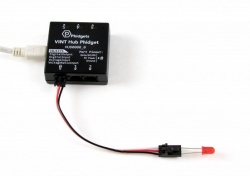
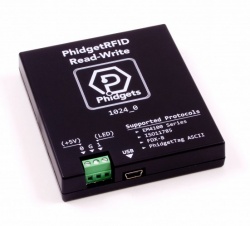
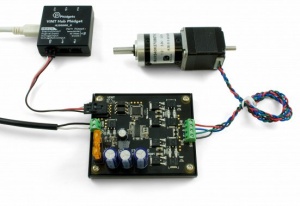
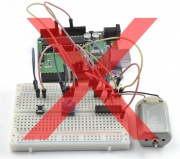
The advantage of using Phidgets is that all Phidgets can be plugged in and used in your project out of the box, without having to follow complex pinout diagrams or configure communication between the device and computer. With Phidgets, we deal with the details of getting the electronics behaving as they should, so you can focus on the programming and details of your final product.
Hardware Introduction
Phidgets connect via a USB port:
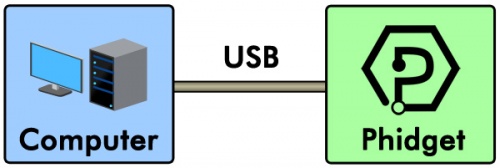
Some Phidgets are a complete, self-contained sensing package. An example is the 1042 , which measures motion:
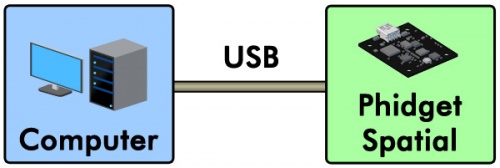
Other Phidgets are a 'building block' to use other sensors. An example is the 1048 which allows the use of wire thermocouples:

Finally, a Phidget may be a VINT Hub, made up of versatile ports that can be used as inputs or outputs, and also connect to smart VINT devices.
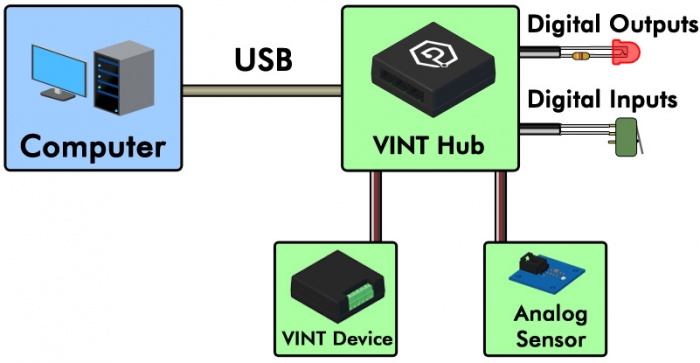
Programming
For the most part, using Phidgets requires writing software. The Phidgets API is available in many different programming languages:
| Core Languages | Mobile Languages | Other Languages |
The Phidget software libraries are supported on a number of operating systems:
| Desktop OSes | Mobile/Wireless OSes |
Network Server
Using the Phidgets API, applications on remote computers, phones, and Single Board Computers can attach to Phidget devices over the network as if they were local. This includes WWW based applications using the Phidget JavaScript library.
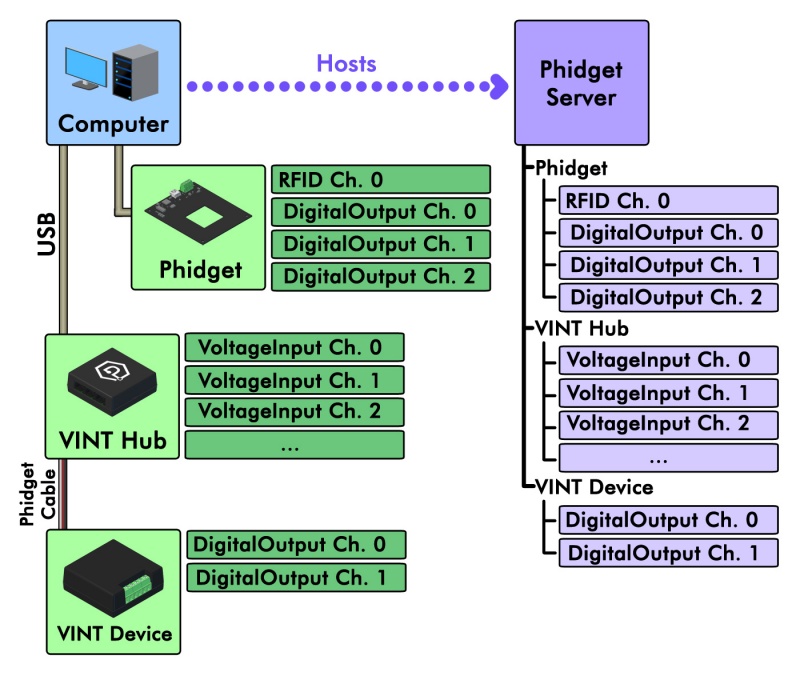
Further Reading
With the combination of events, modular sensors, and network support, your system can range from simple to incredibly complex.
We encourage customers to not only build projects for themselves, but also to design and build real-world products using Phidgets. Our libraries can be distributed with your code to your customers.
Want to learn more? Check out our:
Questions? Please contact us.
